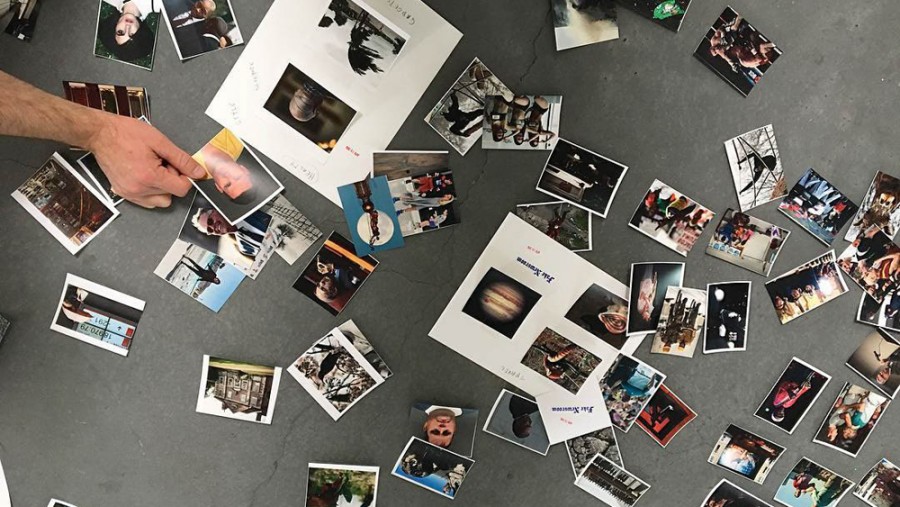‘Fake Newsroom’ Reimagines 1983 Photo Project About Truth and Media
by Sarah Hotchkiss
In a second floor gallery at San Francisco’s Minnesota Street Project, the trappings of a newspaper’s photo department spread themselves across the polished concrete floor in a strange mix of outmoded and modern-day technologies. Heavy wooden desks supporting laptops sit alongside a filing cabinet labelled “MORGUE.” Printed images crowd for floor space next to a paper shredder, while three clocks set to different locations (one always set to the central San Fernando Valley city of Van Nuys) oversee the room’s activity.
This is Fake Newsroom, an ever-evolving installation of photographs culled from the Associated Press, organized into categories, and published daily both online and in good old paper form.
Fake Newsroom is a re-enactment of and elaboration on Newsroom, a 1983 exhibition at the Berkeley Art Museum by photographers and frequent collaborators Mike Mandel and Larry Sultan, who died in 2009. In the BAM gallery space, they installed electronic news and wirephoto machines from AP and United Press International, and, playing the parts of news editors, selected material for new installations twice a week.
A floor-to-ceiling wall vinyl currently installed at Minnesota Street Project shows Sultan behind a desk, Mandel perched on the edge of one in the midst of their Newsroom installation. Both look serious while holding sheets of paper. To their right hangs one of their selections: a giant silver gelatin print of John Glenn at a podium, the eyes of the man behind him glowing eerily in the camera’s flash.
If Sultan and Mandel’s names sound familiar, it could be because of the recently opened Larry Sultan retrospective or the forthcoming Mike Mandel one (both at SFMOMA). Perhaps it’s Casemore Kirkeby’s exhibition of Sultan’s editorial photographs, or the display of the pair’s billboard projects in the gallery adjacent to Fake Newsroom. Take your pick; some have dubbed this “Sultan Spring.”
But Fake Newsroom is more than a timely capitalization on major museum shows. The impetus behind the original staging still feels relevant 34 years later (and perhaps even more so): to examine, through selection, juxtaposition and categorization, the hidden biases of the media. But in 2017, instead of over 200 photographs coming daily down the wire, the Fake Newsroom team gets to choose from thousands of images in the AP database.
Photographers Dru Donovan, Jason Fulford and Jim Goldberg head the operation, shifting responsibility as editors-in-chief over the course of the project’s three-week run. The first changing of the guard was announced playfully on April 18 with the headline “Fulford Fired Goldberg Promoted.” Goldberg is ready, he says, “to generate some fake news with an open heart and open mind.”
Both Goldberg and Donovan studied under Sultan and later worked as his assistants — Goldberg was there for the original 1983 Newsroom, the man responsible for the giant John Glenn print. They’re aided by a small army of volunteers, many of them current students or recent grads of the San Francisco Art Institute’s photography program, where Sultan and Mandel met as M.F.A. candidates in the early ’70s.
Both the physical and digital versions of Fake Newsroom are full of hidden treats for the curious observer. In the gallery, the “Van Nuys” clock is an homage to Sultan and Mandel’s shared hometown; they liked to call themselves “two guys from Van Nuys.” On the website, a click on the triangular symbol in the page’s upper right hand corner flips the entire site into a mirror image of itself, backwards text and all.
And in the corner of Fake Newsroom, the shredder serves just one purpose: to destroy images of President Donald Trump. Visitors are welcome to select their favorite (or least favorite) candid from a small stack and run it through the machine. As Fulford says, “There are no pictures of him in our newspaper.”
What does appear in the paper is a wry blend of image and text. For April 17, in the “Vows” section (the first appearance of a “Vows” section seven days into Fake Newsroom), one photo shows a child high-fiving an adult in a bee costume, while another shows someone in a goldenrod zentai suit giving the camera a thumbs up. For April 11, the “Science” section contains two separate pictures of golfers bending backwards, their faces turned toward the sky.
Fake Newsroom is fake in the sense that it isn’t the Newsroom of 1983, let alone a real newsroom. But at a time when “fake news” casts a shadow of doubt over the veracity of any juxtaposition of image and text, Fake Newsroom separates its images from politics, culture, publication, editorial concern and even the original photographer’s intent. It’s a process too rarely undertaken in our consumption of media, and as the scattered print-outs and carefully assembled compositions of Fake Newsroom prove, it’s also a process that cannot be a passive one.
